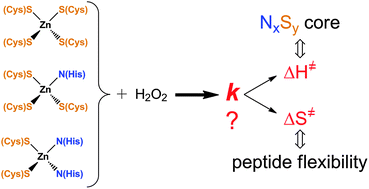Nucleophilic reactivity of Zinc-bound thiolates: subtle interplay between coordination set and conformational flexibility†
Abstract
During the past decades it has been established that zinc-bound cysteines in

* Corresponding authors
a
Laboratoire de Chimie et Biologie des Métaux, CEA/iRTSV/LCBM, UMR 5249 CNRS/Université Joseph Fourier/CEA-Grenoble, 17, rue des Martyrs, 38054 Grenoble, France
E-mail:
olivier.seneque@cea.fr, jean-marc.latour@cea.fr
Fax: +33 438785465
Tel: +33 438782144
During the past decades it has been established that zinc-bound cysteines in

 Please wait while we load your content...
Something went wrong. Try again?
Please wait while we load your content...
Something went wrong. Try again?
M. Isaac, J. Latour and O. Sénèque, Chem. Sci., 2012, 3, 3409 DOI: 10.1039/C2SC21029K
To request permission to reproduce material from this article, please go to the Copyright Clearance Center request page.
If you are an author contributing to an RSC publication, you do not need to request permission provided correct acknowledgement is given.
If you are the author of this article, you do not need to request permission to reproduce figures and diagrams provided correct acknowledgement is given. If you want to reproduce the whole article in a third-party publication (excluding your thesis/dissertation for which permission is not required) please go to the Copyright Clearance Center request page.
Read more about how to correctly acknowledge RSC content.
 Fetching data from CrossRef.
Fetching data from CrossRef.
This may take some time to load.
Loading related content
